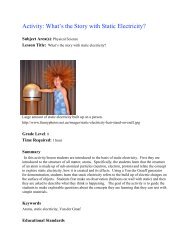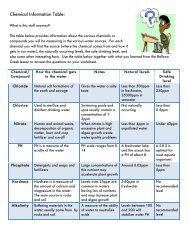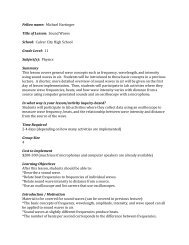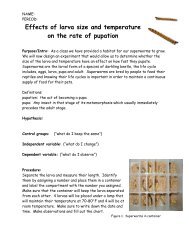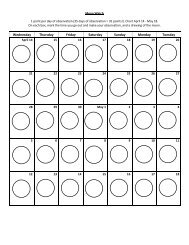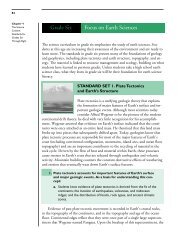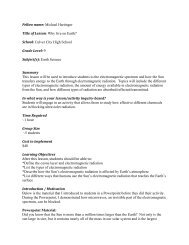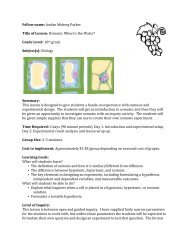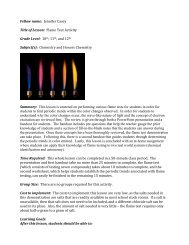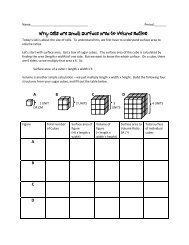Fellow name: Sara Painter Title of Lesson: Becoming Whale Grade ...
Fellow name: Sara Painter Title of Lesson: Becoming Whale Grade ...
Fellow name: Sara Painter Title of Lesson: Becoming Whale Grade ...
Create successful ePaper yourself
Turn your PDF publications into a flip-book with our unique Google optimized e-Paper software.
<strong>Fellow</strong> <strong>name</strong>: <strong>Sara</strong> <strong>Painter</strong> <br />
<strong>Title</strong> <strong>of</strong> <strong>Lesson</strong>: <strong>Becoming</strong> <strong>Whale</strong><br />
<strong>Grade</strong> Level: 7 th grade Life Science<br />
Subject(s): Evolution – evidence for change over time<br />
Summary:<br />
This lesson is designed to give students a firsthand experience <strong>of</strong> how scientists use the<br />
fossil record to generate ideas about the evolutionary history <strong>of</strong> modern day species. The<br />
lesson has two parts. In part one the students will be gather information that will allow<br />
them to discover who were the ancestors to modern day whales and what evolutionary<br />
transitions occurred as whale evolved from land dwelling to marine mammals. The students<br />
will “dig” through cups (soil layers) and discover fossils. They will use a combination <strong>of</strong><br />
information including the laws <strong>of</strong> superposition, radioactive carbon dating and intuition to<br />
generate a hypothetical phylogeny <strong>of</strong> whales. In part 2 the students will see how the<br />
evolution <strong>of</strong> whales fits into the larger geologic time scale. The students will create a time<br />
scale with their bodies starting from the formation <strong>of</strong> the earth and ending with modern<br />
human civilization. Each student will received a major event in earths history and a time<br />
point and they will need to form a big circle around the classroom standing in the correct<br />
order.<br />
Time required/planned for:<br />
Part 1<br />
- Introduction 20 min<br />
- Lab activity 30 min<br />
- Review 10 min<br />
Part 2<br />
- Geologic time scale activity 15 min<br />
- Rap Up 15 min<br />
Group Size:<br />
2-4 students per group
Cost to implement:<br />
- Each group will need:<br />
o Eight plastic cups (~$0.50)<br />
o Several copies <strong>of</strong> each skeleton type (one per student)<br />
o Tape (~$2.00)<br />
o Worksheet (one per student)<br />
Learning Goals:<br />
- After this lesson students should:<br />
o understand how fossils provide evidence for the evolutionary history <strong>of</strong><br />
animals<br />
o have improved ability to build and interpret branching tree diagrams<br />
o be able to describe how the Cambrian explosion got its <strong>name</strong><br />
o be able to put major events in earths history in the correct order<br />
Level <strong>of</strong> Inquiry:<br />
- Students will be investigating the answer to the question “who were the ancestors <strong>of</strong><br />
modern day whales?”<br />
- The students will first make hypotheses and predictions regarding the characteristics<br />
they would expect a whale ancestor to have.<br />
- They will then gather evidence by discovering fossils and using the law <strong>of</strong><br />
superposition to place each skeleton on the timeline to create the history <strong>of</strong> whales.<br />
The students will not be given the correct answer and will need to argue with their<br />
classmates about which tree is the best and why.<br />
Introduction / Motivation:<br />
This lesson will be introduced using a power point presentation. At the beginning <strong>of</strong> the<br />
presentation show pictures <strong>of</strong> some whales and dolphins and ask the students to identify<br />
what they see. Ask students to discuss with their neighbors and write own three<br />
characteristics that all whales share. Have a class discussion about their answers. Lead the<br />
students through a logical argument that whales are mammals and thus, share<br />
characteristics with other mammals (some <strong>of</strong> the students may have come to this<br />
conclusion already). Now explain that we know from fossil evidence that mammals evolved<br />
on land and thus, we can conclude that whales must have evolved from land mammals as<br />
well.<br />
Next introduce the following question which will be the basis <strong>of</strong> the lab investigation:<br />
- How did whales evolve from land mammals?<br />
Before explaining the lab activity I will ask the students/we will discuss the following:<br />
o What kind <strong>of</strong> evidence would you need to answer this question?<br />
o Answer: Fossils <strong>of</strong> intermediate forms showing a transition from a life on land<br />
to a life in the water in their skeletal structure.<br />
Next ask the students to make some predictions, based on what you have discussed this<br />
far, regarding the characteristics they would expect a whale ancestor to have.<br />
- To aid their thinking display the following diagram via powerpoint and ask the<br />
students to make prediction about what should go in the question mark spaces.
Now introduce the lab activity by reading the following paragraph while they follow along on<br />
their worksheet:<br />
Imagine that you are an archeologist. Together with your team<br />
<strong>of</strong> scientists you are trying to answer the following question:<br />
How did whales evolve from land mammals?<br />
To answer this question you and your fellow scientists spent<br />
several years excavating skeletons <strong>of</strong> animals you believe to<br />
be possible ancestors to modern day whales. You have<br />
brought these skeletons home to you lab for closer<br />
examination. The approximate dates <strong>of</strong> each fossil have just<br />
come back from the radioactive dating lab. Now you will use this data to reconstruct<br />
the history <strong>of</strong> whales on the timeline provided.<br />
Procedure:<br />
Part 1 Lab:<br />
Set up and instructions:<br />
Set up several lab stations around the classroom such that there will be no more than four<br />
students per group. Each station will need eight plastic cups labeled A, B, C…H. The cups<br />
should be stacked so that A is on the top and H is on the bottom. In each cup should be the<br />
following skeleton species.<br />
A = Tursiops and Eubalana<br />
B = Zygorhiza<br />
C = Physter and Balenoptera<br />
D = Diorocetus<br />
E = Ambulocetus<br />
F = Durodon and Basilosaurus<br />
G = Diacodexis<br />
H = Indohyus and Pakicetus<br />
Each lab station should also have a copy <strong>of</strong> the radio active dating table below:
Activity:<br />
Soil Layer (cup) Time Period (mya)<br />
A 5-11<br />
B 26-32<br />
C 12-18<br />
D 19-25<br />
E 40-46<br />
F 33-39<br />
G 54-60<br />
H 47-53<br />
Starting with cup A students should “dig” for fossils. Each student should get one copy <strong>of</strong><br />
every fossil type in the cup (soil layer). They will then need to use the table <strong>of</strong> radio activity<br />
dating <strong>of</strong> each soil layer to find out which time period the fossil is from. Using this<br />
information they should put the fossil in the correct empty box on the timeline on their<br />
worksheet. By the end <strong>of</strong> the lab each box should have a whale fossil. Once the students<br />
are satisfied with the timeline they have created have them tape down each <strong>of</strong> the whale<br />
fossils.<br />
Part 1 Closure:<br />
When the students are finished collecting and graphing their data lead the class through a<br />
discussion by asking them to reconstruct the phylogeny <strong>of</strong> whales using the evidence they<br />
collected. Draw a timeline up on the white board, identical to the one on their worksheet.<br />
Print out larger versions <strong>of</strong> the 12 skeleton types. Have student volunteer to tape the 12<br />
skeletons up on the board in the location they think it should be. Once all the pictures are<br />
taped on the board ask the class whether they agree or disagree with the whale history on<br />
the board. Ask those who disagree to explain where and why. For any discrepancies<br />
pointed out by the students take a class vote on how the tree should be rearranged. Move<br />
any necessary skeletons to as direction by the majority vote.<br />
Do not tell the student the correct answer, but instead use this as a platform to launch a<br />
discussion about how scientists can never know the correct answer regarding evolutionary<br />
relationship between fossil organisms. Explain how scientists have to take their best guess<br />
given the information provided. Explain the problems with using the fossil record and the<br />
many ways in which it is incomplete.<br />
Part 2<br />
set up instructions:
Create a timeline around the classroom by taping large number 0, 100, 200,….1000 around<br />
the classroom at roughly equally spaced intervals. Print out the major events in earth’s<br />
history and cut them into strips.<br />
Activity:<br />
Randomly hand out one strip <strong>of</strong> paper to each <strong>of</strong> the students. Explain that they will be<br />
recreating the geological time scale using the major events in earth’s history. Explain that<br />
instead <strong>of</strong> speaking in millions and billions <strong>of</strong> years (abstract concept) that you have<br />
recreated the time scale to be more familiar. 1000 is the beginning <strong>of</strong> our planet and the<br />
time the earth was formed. 0 is today. Have the students find their appropriate position on<br />
the time scale tapped up around the classroom.<br />
The majority <strong>of</strong> the students should be clustered between the 100 and the 0. Stop them<br />
and ask why they are so clustered and crowded together. Explain to the student that this<br />
actually what earth’s history looks like. It begins with long expanses <strong>of</strong> time were not much<br />
happened. In fact, this is most <strong>of</strong> earth’s history. It is only recently, after the Cambrian<br />
explosion, when most <strong>of</strong> the stuff we consider to be interesting happened.<br />
Now, for the sake <strong>of</strong> elbow room, have the students ignore the time scale taped around the<br />
room and instead spread out to form a nice complete equally spaced circle. Starting with<br />
the formation <strong>of</strong> the earth have each student read their major even in earth’s history and<br />
the relative time point.<br />
One the students have returned to their seats use the last power point slide to emphasize<br />
and discuss what they just discovered.<br />
Is this lesson based upon or modified from existing materials? If yes, please<br />
specify source(s) and explain how related:<br />
Yes, I modified a lesson on whale evolution that I found online:<br />
http://www.indiana.edu/~ensiweb/lessons/whale.ev.html<br />
References:<br />
Evolution <strong>of</strong> cetaceans:<br />
http://en.Wikipedia.org/wiki/Evolution_<strong>of</strong>_cetaceans<br />
The origin <strong>of</strong> <strong>Whale</strong>s and the power <strong>of</strong> Independent Evidence<br />
http://www.talkorigis.org/features/whales<br />
Attachments:<br />
- <strong>Becoming</strong> whale worksheet<br />
- <strong>Becoming</strong> whale powerpoint<br />
- Major events in earths history<br />
- Mini and large whale ancestor fossils<br />
- Numbers 0-1000
List CA Science Standards addressed:<br />
<br />
Evolution:<br />
3.c. Students know how independent lines <strong>of</strong> evidence from geology, fossils, and<br />
comparative anatomy provide the bases for the theory <strong>of</strong> evolution.<br />
3.d Students know how to construct a simple branching diagram to classify living groups <strong>of</strong><br />
organisms by shared derived characteristics and how to expand the diagram to include fossil<br />
organisms.<br />
Earth History:<br />
4.e. Students know fossils provide evidence <strong>of</strong> how life and environmental conditions have<br />
changed.<br />
4.g. Students know how to explain significant developments and extinctions <strong>of</strong> plant and<br />
animal life on the geologic time scale.



